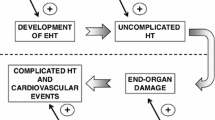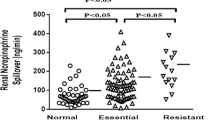Abstract
Abundant evidence supports a role of the sympathetic nervous system in the pathogenesis of obesity-related hypertension. However, the nature and temporal progression of mechanisms underlying this sympathetically mediated hypertension are incompletely understood. Recent technological advances allowing direct recordings of renal sympathetic nerve activity (RSNA) in conscious animals, together with direct suppression of RSNA by renal denervation and reflex-mediated global sympathetic inhibition in experimental animals and human subjects have been especially valuable in elucidating these mechanisms. These studies strongly support the concept that increased RSNA is the critical mechanism by which increased central sympathetic outflow initiates and maintains reductions in renal excretory function, causing obesity hypertension. Potential determinants of renal sympathoexcitation and the differential mechanisms mediating the effects of renal-specific versus reflex-mediated, global sympathetic inhibition on renal hemodynamics and cardiac autonomic function are discussed. These differential mechanisms may impact the efficacy of current device-based approaches for hypertension therapy.

Similar content being viewed by others
References
Papers of particular interest, published recently, have been highlighted as: •Of Importance
Esler M, Straznicky N, Eikelis N, et al. Mechanisms of sympathetic activation in obesity-related hypertension. Hypertension. 2006;48:787–96.
Hall JE, da Dilva AA, Brandon E, et al. Pathophysiology of obesity-induced hypertension and target organ damage. In: Lip GYH, Hall JE, editors. Comprehensive Hypertension. New York: Elsevier; 2007. p. 447–68.
• Bisognano JD, Bakris G, Nadim MK, et al. Baroreflex activation therapy lowers blood pressure in patients with resistant hypertension: results from the double-blind, randomized, placebo-controlled Rheos Pivotal trial. J Am Coll Cardiol. 2011;58:765–73. The first randomized controlled trial investigating safety and efficacy of baroreflex activation therapy as treatment for resistant hypertension.
Lohmeier TE, Iliescu R. Chronic lowering of blood pressure by carotid baroreflex activation. Mechanisms and potential for hypertension therapy. Hypertension. 2011;57:880–6.
Schlaich MP, Sobotka PA, Krum H, et al. Renal denervation as a therapeutic approach for hypertension. Novel implications for an old concept. Hypertension. 2009;54:1195–201.
• Esler MD, Krum H, Sobotka PA, et al. Renal sympathetic denervation in patients with treatment resistant hypertension (The Symplicity HTN-2 Trial): a randomized controlled trial. Lancet. 2011;376:1903–9. The first randomized controlled trial investigating safety and efficacy of catheter-based renal denervation as treatment for resistant hypertension.
Esler MD, Krum H, Schlaich M, et al. Renal sympathetic denervation for treatment of drug-resistant hypertension. One-year results from Symplicity HTN-2 randomized, controlled trial. Circulation. 2012;126:2976–82.
Heusser K, Tank J, Engeli S, et al. Carotid baroreceptor stimulation, sympathetic activity, baroreflex function, and blood pressure in hypertensive patients. Hypertension. 2010;55:619–26.
Lohmeier TE, Iliescu R, Dwyer TM, et al. Sustained suppression of sympathetic activity and arterial pressure during chronic activation of the carotid baroreflex. Am J Physiol Heart Circ Physiol. 2010;299:H402–9.
Hering D, Lambert EA, Marusic P, et al. Substantial reduction in single sympathetic nerve firing after renal denervation in patients with resistant hypertension. Hypertension. 2013;61:457–64.
Brinkmann J, Heusser K, Schmidt BM, et al. Catheter-based renal nerve ablation and centrally generated sympathetic activity in difficult-to-control hypertensive patients. Prospective case studies. Hypertension. 2012;60:1485–90.
Calhoun DA, Jones D, Textor S, et al. Resistant hypertension: diagnosis, evaluation, and treatment. Circulation. 2008;117:e510–26.
Guyton AC. Arterial Pressure and Hypertension. Philadelphia, PA: Saunders; 1980.
Lohmeier TE, Hildebrandt DA, Warren S, et al. Recent insights into the interactions between the baroreflex and the kidneys in hypertension. Am J Physiol Regulatory Integrative Comp Physiol. 2005;288:R828–36.
Lohmeier TE, Drummond HA. The baroreflex in the pathogenesis of hypertension. In: Lip GYH, Hall JE, editors. Comprehensive Hypertension. New York: Elsevier; 2007. p. 265–79.
Lohmeier TE, Iliescu R. Lowering of blood pressure by chronic suppression of central sympathetic outflow: insight from prolonged baroreflex activation. J Appl Physiol. 2012;113:1652–8.
DiBona GF, Kopp UC. Neural control of renal function. Physiol Rev. 1997;77:75–197.
Vaz M, Jennings G, Turner A. Regional sympathetic nervous activity and oxygen consumption in obese normotensive human subjects. Circulation. 1997;96:3423–9.
Rumantir MS, Vaz M, Jennings GL, et al. Neural mechanisms in human obesity-related hypertension. J Hypertens. 1999;17:1125–33.
Kassab S, Kato T, Wilkins C, et al. Renal denervation attenuates the sodium retention and hypertension associated with obesity. Hypertension. 1995;25:893–7.
• Lohmeier TE, Iliescu R, Liu B, et al. Systemic and renal-specific sympathoinhibition in obesity hypertension. Hypertension. 2012;59:331–8. Demonstrates both similar and differential effects of chronic baroreflex activation and renal denervation on arterial pressure, neurohormonal responses, renal function, and heart rate in dogs with obesity-induced hypertension.
Armitage JA, Burke SL, Prior LJ, et al. Rapid onset of renal sympathetic nerve activation in rabbits fed a high-fat diet. Hypertension. 2012;60:163–71.
Schlaich MP, Sobotka PA, Krum, et al. Renal sympathetic-nerve ablation for uncontrolled hypertension. N Engl J Med. 2009;361:932–4.
Tomaszewski M, Charchar, Maric C. Glomerular hyperfiltration: a new marker of metabolic risk. Kidney Int. 2007;71:816–21.
• Lambert E, Sari CI, Daywood T, et al. Sympathetic Nervous System Activity is associated with obesity-induced subclinical organ damage in young adults. Hypertension. 2010;56:351–8. This study provides early evidence for glomerular hyperfiltration, a precursor of kidney disease, in parallel with increases in systolic blood pressure and muscle sympathetic nerve activity in overweight/obese college students when compared to their lean counterparts.
Iliescu R, Irwin ED, Georgakopoulos D, Lohmeier TE. Renal responses to chronic suppression of central sympathetic outflow. Hypertension. 2012;60:749–56.
Mahfoud F, Cremers B, Link B, et al. Renal hemodynamics and renal function after catheter-based sympathetic denervation in patients with resistant hypertension. Hypertension. 2012;60:419–24.
Hering D, Mahfoud F, Walton AS, et al. Renal denervation in moderate to severe CKD. J Am Soc Nephrol. 2012;23:1250–7.
Alnima T, de Leeuw PW, Tan ES, Kroon AA. Renal responses to long-term carotid baroreflex activation therapy in patients with drug-resistant hypertension. Hypertension 2013, In press.
Poirier P, Giles TD, Bray GA, et al. Obesity and cardiovascular disease: pathophysiology, evaluation, and effect of weight loss: an update of the 1997 American Heart Association Scientific Statement on Obesity and Heart Disease from the Obesity Committee of the Council on Nutrition, Physical Activity, and Metabolism. Circulation. 2006;113:898–918.
Wang TJ, Parise H, Levy D, et al. Obesity and the risk of new-onset atrial fibrillation. J Am Med Assoc. 2004;292:2471–7.
Pietrasik G, Goldenberg I, McNitt S, et al. Obesity as a risk factor for sustained ventricular tachyarrhythmias in MADIT II patients. J Cardiovasc Electrophysiol. 2007;18:181–4.
Wanahita N, Messerli FH, Bangalore S, et al. Atrial fibrillation and obesity—results of meta-analysis. Am Heart J. 2008;155:310–5.
Tu W, Eckert GJ, DiMeglio LA, et al. Intensified effect of adiposity on blood pressure on overweight and obese children. Hypertension. 2011;58:818–24.
Van Vliet BN, Hall JE, Mizelle HL, et al. Reduced parasympathetic control of heart rate in obese dogs. Am J Physiol Heart Circ Physiol. 1995;269:H629–37.
Aronne LJ, Mackintosh R, Rosenbaum M, et al. Autonomic nervous system activity in weight gain and weight loss. Am J Physiol Regul Integr Comp Physiol. 1995;269:R222–5.
Truett AA, Borne AT, Poincot MA, West DB. Autonomic control of blood pressure and heart rate in obese hypertensive dogs. Am J Physiol Regul Integr Comp Physiol. 1996;270:R541–9.
Tsuji H, Venditti Jr FJ, Manders ES, et al. Reduced heart rate variability and mortality risk in an elderly cohort. The Framingham Heart Study. Circulation. 1994;90:878–83.
Tsuji H, Larson MG, Venditti FJ, et al. Impact of reduced heart rate variability on risk for cardiac events. The Framingham Heart Study. Circulation. 1996;94:2850–5.
Reed MJ, Robertson CE, Addison PS. Heart rate variability measurements and the prediction of ventricular arrhythmias. QJM. 2005;98:87–95.
Billman GE. Heart rate variability – a historical perspective. Front Physiol. 2011;2:1–13.
Schwartz PJ, De Ferrari GM. Sympathetic-parasympathetic interaction in health and disease: abnormalities and relevance in heart failure. Heart Fail Rev. 2011;16:101–7.
Grassi G, Seravalle G, Dell’Oro R, et al. Adrenergic and reflex abnormalities in obesity-related hypertension. Hypertension. 2000;36:538–42.
Beske S, Alvarez GE, Ballard TP, Davy KP. Reduced cardiovagal baroreflex gain in visceral obesity: implications for the metabolic syndrome. Am J Physiol Heart Circ Physiol. 2002;282:H630–5.
Skrapari I, Tentolouris T, Perrea D, et al. Baroreflex sensitivity in obesity: relationship with cardiac autonomic nervous system activity. Obesity. 2007;15:1685–93.
• Grassi G, Seravalle G, Quarti-Trevano F, et al. Reinforcement of the adrenergic overdrive in the metabolic syndrome complicated by obstructive sleep apnea. J Hypertens. 2010;28:1313–20. Measurements of muscle sympathetic nerve activity show that the sympathetic activation of metabolic syndrome occurs independently of obstructive sleep apnea (OSA) but that OSA has sustained effects to potentiate the sympathoexcitation.
Iliescu R, Tudorancea E, Irwin E, Lohmeier TE. Chronic baroreflex activation improves baroreflex control of heart rate in obesity. Hypertension. 2012;60:A477.
Shankar A, Xiao J. Positive relationship between plasma leptin level and hypertension. Hypertension. 2010;56:623–8.
Mark AL, Shaffer RA, Correia MLG, et al. Contrasting blood pressure effects of obesity in leptin-deficient ob/ob mice and agouti yellow obese mice. J Hypertens. 1999;17:1949–53.
• Lim K, Burke SL, Head GA. Obesity-related hypertension and the role of insulin and leptin in high-fat-fed rabbits. Hypertension. 2013;61:628–34. Demonstrates that the central actions of endogenous leptin stimulate renal sympathetic nerve activity in conscious, obese hypertensive rabbits.
Eikelis N, Schlaich M, Aggarwal A, et al. Interactions between leptin and the human sympathetic nervous system. Hypertension. 2003;41:1072–9.
Wolk R, Abu SM. Shamsuzzaman, Somers VK. Obesity, sleep apnea, and Hypertension. Hypertension. 2003;42:1067–74.
Witkowski A, Prejbisz A, Florczak E. Effects of renal sympathetic denervation on blood pressure, sleep apnea course, and glycemic control in patients with resistant hypertension and sleep apnea. Hypertension. 2011;58:559–65.
Friedman O, Bradley TD, Chan CT, et al. Relationship between overnight rostral fluid shift and obstructive sleep apnea in drug-resistant hypertension. Hypertension. 2010;56:1077–82.
Huber DA, Schreihofer AM. Attenuated baroreflex control of sympathetic nerve activity in obese Zucker rats by central mechanisms. J Physiol. 2010;588(9):1515–25.
McCully BH, Brooks VL, Andresen MC. Diet-induced obesity severly impairs myelinated aortic baroreceptor reflex responses. Am J Physiol Heart Circ Physiol. 2012;302:H2083–91.
Lohmeier TE, Warren S, Cunningham JT. Sustained activation of the central baroreceptor pathway in obesity hypertension. Hypertension. 2003;42:96–102.
Acknowledgments
The authors’ studies cited in this report were funded by National Heart, Lung, and Blood Institute Grant HL-51971.
Conflict of Interest
Thomas E. Lohmeier has received consulting fees from CVRx and research support from National Institutes of Health.
Radu Iliescu declares that he has no conflict of interest.
Author information
Authors and Affiliations
Corresponding authors
Rights and permissions
About this article
Cite this article
Lohmeier, T.E., Iliescu, R. The Sympathetic Nervous System in Obesity Hypertension. Curr Hypertens Rep 15, 409–416 (2013). https://doi.org/10.1007/s11906-013-0356-1
Published:
Issue Date:
DOI: https://doi.org/10.1007/s11906-013-0356-1




